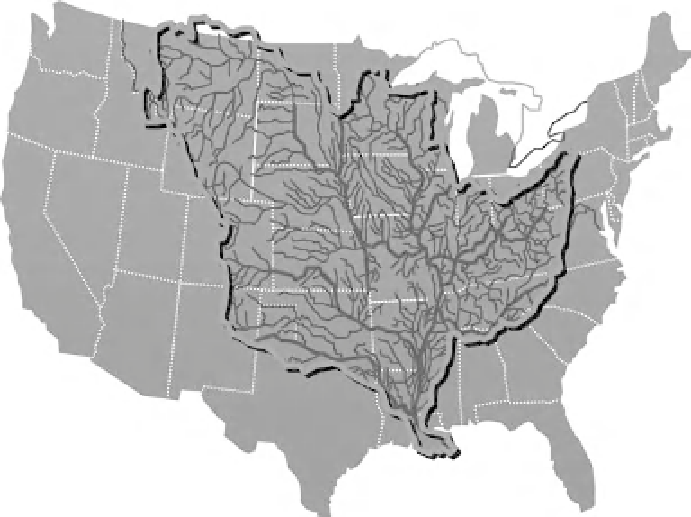Environmental Engineering Reference
In-Depth Information
Fig. 25.1
The Mississippi
River Basin. (See the calour version
of this figure in Colour Plate
section.).
River Commission Act 1879). The creation of the
Commission followed a detailed study of possible
flood control approaches conducted by the US
Army Corps of Engineers (Corps) in the 1860s,
which recommended the use of levees to channel
the Mississippi and reduce flood damages (Hum-
phreys and Abbott 1861). Because of arguments
in the US Congress over the constitutionality of
federal support of flood control, the Commission
was not appropriated significant funds to deal with
flood control. After disastrous floods in California
and the Mississippi River Valley shortly after the
turn of the century, the Congress authorized the
Corps to increase its support of flood control ac-
tivities in both the lowerMississippi Valley and in
the Sacramento River in California, and increased
the appropriations for these efforts (Arnold 1988).
In 1927, a major flood wreaked havoc on the
lower Mississippi River Valley and brought na-
tional attention to the risk being faced by those
who lived along the river, farmed the rich alluvial
lands, and populated the major cities. Hundreds
of thousands were driven from their homes for
months and the economic losses were staggering
for those in the Southern states. Congress reacted
by passing the Flood Control Act of 1928, which
assigned theCorps and theMississippi RiverCom-
mission responsibility for development and oper-
ation of a flood control system for the lower
Mississippi Valley. Eight years later, following
major flooding across the nation, the Congress
passed the Flood Control Act of 1936, which in-
dicated that 'the Federal Government should im-
prove or participate in the improvement of
navigable waters or their tributaries including
watersheds thereof, for flood-control purposes if
the benefits towhomsoever theymay accrue are in
excess of the estimated costs, and if the lives and
social security of people are otherwise adversely
affected.' TheAct gave theCorps responsibility for
controlling floods around the nation using tech-
niques that it had put into use over the previous
decades - levees, floodways and dams.
In the 1960s, spurred on by the work of the
geographer Gilbert F. White and with the continu-
ing rise in flood damages, many began to advocate
use of non-structural approaches to reducing flood
damages. In 1968, the Congress authorized the
establishment of the National Flood Insurance
Program (NFIP), which would offer flood insur-
ance for purchase by floodplain residents (Nation-
al Flood Insurance Act 1968). In 1970, the
President signed the National Environmental Pol-
icyAct (NEPA), establishing a clearUS position on

